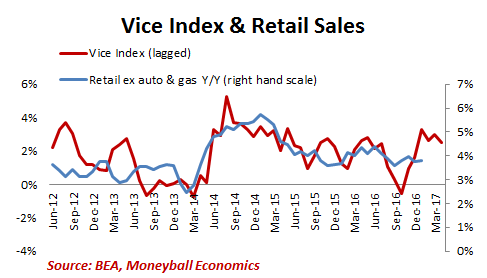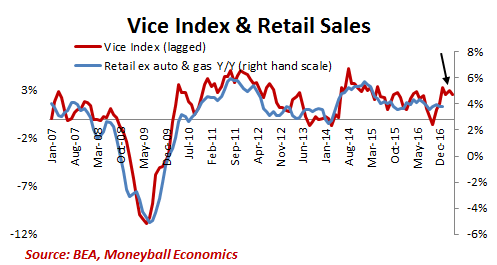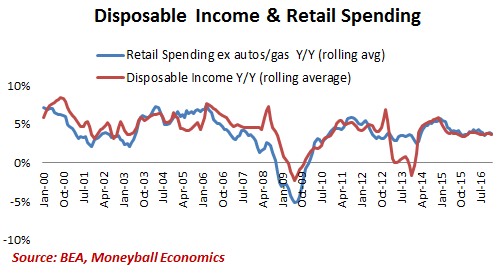
Retail Spending Pace is Peaking
Vice Index points to steady consumer spending… But it is going to slow in the next few months.
The nominal spending level continues to expand (more people are entering the workforce and wages are growing). But it’s growing at a slower pace. This month will see a favorable year-over-year (yr/yr) growth rate but that’s because last year was so low. Going forward the pace is set to slow.

On a month-over-month (m/m) basis, Retail spending (ex Autos & Gas) is pointing to a slightly lower 0.2% average growth for 1Q17 (slightly below previous expected pace of 0.2%~0.3%).

Update From Last Month’s Report
The Vice Index may be too optimistic though.
The VI typically leads retail spending (ex Autos & Gas) by four months. But, like all leading indicators, it loses some accuracy when there are sudden external economic shocks… like a surge in oil prices or higher interest rates.
As I pointed out last month, the VI “does not include the surge in oil prices. December data will give better insight.
Vice Index says retail spending peaks in January and then flattens.
But disposable income may slow sooner.
Meanwhile, consumer spending is already shifting away from luxury (an early indicator of slower consumer spending).”
The December retail data confirmed my suspicion: higher prices at the pump are squeezing out discretionary spending. Gasoline spending rose $0.7B and Food Services dropped $0.5B.
Current: Vice Index Points Slightly Slower Pace In Spending
The Vice Index pace of spending has pulled back.
This is also consistent with the slower wage growth and disposable income.

Unless wage growth picks up again, retail spending will continue to slow.
Slower consumer spending is not something companies want at a time when their margins are getting squeezed by higher input costs and higher healthcare subsidies.
(Many companies absorb the bulk of the healthcare insurance inflation).













Leave A Comment